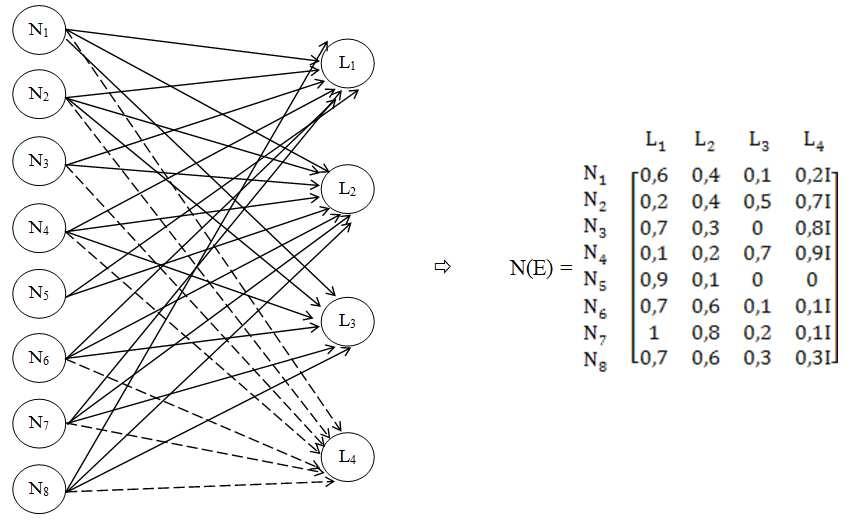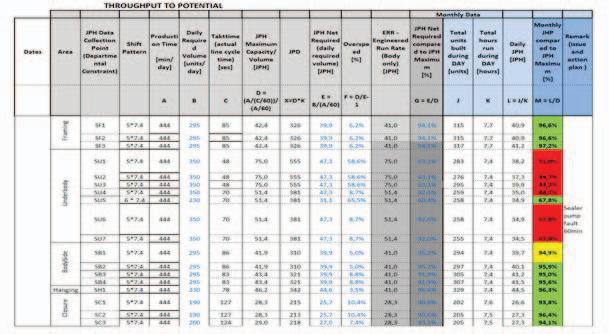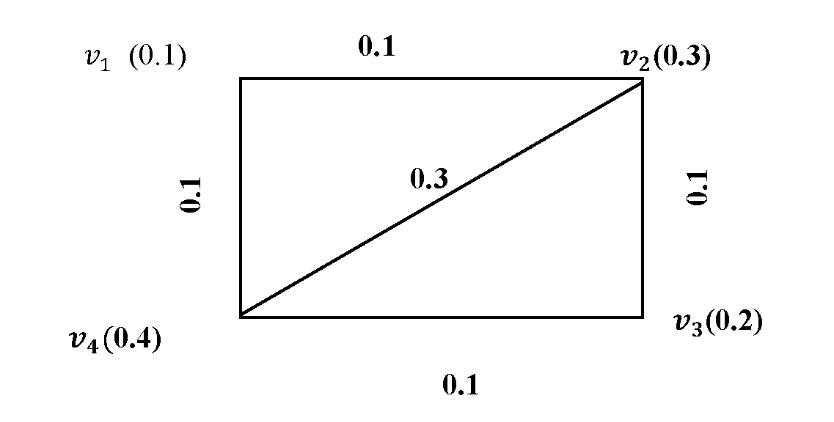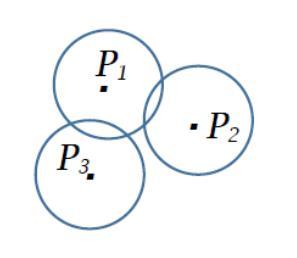
14 minute read
I,T)-Standard neutrosophic rough set and its topologies properties
Nguyen Xuan Thao, Florentin Smarandache
Advertisement
Nguyen Xuan Thao, Florentin Smarandache (2016). (I,T)-Standard neutrosophic rough set and its topologies properties. Neutrosophic Sets and Systems 14: 65-70
Abstract. In this paper, we defined (��,��)− standard neutrosophic rough sets based on an implicator �� and a tnorm �� on ��∗; lower and upper approximations of standard neutrosophic sets in a standard neutrosophic approximation are defined. Some properties of (��,��)− standard neutrosophic rough sets are investigated. We consider the case when the neutrosophic components (truth, indeterminacy, and falsehood) are totallydependent, single-valued, and hence their sum is ≤ 1.
Keywords: standard neutrosophic, (��,��)− standard neutrosophic rough sets
1. Introduction
Rough set theory was introduced by Z. Pawlak in 1980s [1]. It becomes a useful mathematical tool for data mining, especially for redundant and uncertain data. At first, the establishment of the rough set theory is based on equivalence relation. The set of equivalence classes of the universal set, obtained by an equivalence relation, is the basis for the construction of upper and lower approximation of the subset of the universal set.
Fuzzy set theory was introduced by L.Zadeh since 1965 [2]. Immediately, it became a useful method to study the problems of imprecision and uncertainty. Since, a lot of new theories treating imprecision and uncertainty have been introduced. For instance, Intuitionistic fuzzy sets were introduced in1986, by K. Atanassov [3], which is a generalization of the notion of a fuzzy set. When fuzzy set give the degree of membership of an element in a given set, Intuitionistic fuzzy set give a degree of membership and a degree of non-membership of an element in a given set. In 1998 [22], F. Smarandache gave the concept of neutrosophic set which generalized fuzzy set and intuitionistic fuzzy set. This new concept is difficult to apply in the real appliction. It is a set in which each proposition is estimated to have a degree of truth (T), adegree of indeterminacy (I) and a degree of falsity (F). Over time, the subclass of neutrosophic sets was proposed. They are also more advantageous in the practical application. Wang et al. [11] proposed interval neutrosophic sets and some operators of them. Smarandache [22] and Wang et al. [12] proposed a single valued neutrosophic set as an instance of the neutrosophic set accompanied with various set theoretic operators and properties. Ye [13] defined the concept of simplified neutrosophic sets, it is a set where each element of the universe has a degree of truth, indeterminacy, and falsity respectively and which lie between [0, 1] and some operational laws for simplified neutrosophic sets and to propose two aggregation operators, including a simplified neutrosophic weighted arithmetic average operator and a simplified neutrosophic weighted geometric average operator. In 2013, B.C. Cuong and V. Kreinovich introduced the concept of picture fuzzy set [4,5], and picture fuzzy set is regarded the standard neutrosophic set [6].
More recently, rough set have been developed into the fuzzy environment and obtained many interesting results. The approximation of rough (or fuzzy) sets in fuzzy approximation space gives us the fuzzy rough set [7,8,9]; and the approximation of fuzzy sets in crisp approximation space gives us the rough fuzzy set [8, 9]. In 2014, X.T. Nguyen introduces the rough picture fuzzy set as the result of approximation of a picture fuzzy set with respect to a crisp approximation space [18]. Radzikowska and Kerre defined (��,��)− fuzzy rough sets [19], which determined by an implicator �� and a t-norm �� on [0,1]. In 2008, L. Zhou et al. [20] constructed (��,��)− intuitionistic fuzzy rough sets determined by an implicator �� and a t-norm �� on ��∗ .
In this paper, we considered the case when the neutrosophic components are single valued numbers in [0, 1] and they are totally dependent [17], which means that their sum is ≤ 1. We defined (��,��)− standard neutrosophic rough sets based on an implicator �� and a t-norm �� on ��∗; in which, implicator �� and a t-norm �� on ��∗ is investigated in [21].
2. Standard neutrosophic logic
We consider the set ��∗ defined by the following definition. Definition 1. We denote: ��∗ ={�� =(��1,��2,��3)|��1 +��2 +��3 ≤1,���� ∈[0,1],�� =1,2,3} For �� =(��1,��2,��3),��=(��1,��2,��3)∈��∗, we define:
�� ≤��∗ �� iff ((��1 <��1)∧(��3 ≥��3))∨((��1 = ��1)∧(��3 >��3))∨((��1 =��1)∧(��3 =��3)∧(��2 ≤��2)) , and �� =��⟺(�� ≤��∗ ��)∧ ( �� ≤��∗ ��). Then (��∗ ,≤��∗) is a lattice, in which 0��∗ =(0,0,1)≤�� ≤ 1��∗ =(1,0,0),∀�� =(��1,��2,��3)∈��∗ . The meet operator ∧ and the join operator ∨ on (��∗ ,≤��∗) are defined as follows: For �� =(��1,��2,��3),��=(��1,��2,��3)∈��∗ , ��∧�� =(min(��1,��1),min(��2,��2),max(��3,��3)), ��∨��=(max(��1,��1),min(��2,��2),min(��3,��3)).
On ��∗, we consider logic operators as negation, t-norm, t-conorm, implication.
2.1. Standard neutrosophic negation
Definition 2. A standard neutrosophic negation is any nonincreasing ��∗ →��∗ mapping �� satisfying ��(0��∗)= 1��∗ và ��(1��∗)=0��∗ . Example 1. For all �� =(��1,��2,��3)∈��∗, we have some standard neutrosophic negations on ��∗ as follows: + ��0(��)=(��3,0,��1) + ��1(��)=(��3,��4,��2) where ��4 =1−��1 −��2 −��3.
2.2. Standard neutrosophic t-norm
For �� =(��1,��2,��3)∈��∗, we denote
Γ(��)={��∈��∗ :�� =(��1,��2,��3),0≤��2 ≤��2} Obviously, we have Γ(0��∗)=0��∗ , Γ(1��∗)=1��∗ . Definition 3. A standard neutrosophic t-norm is an (��∗)2 → ��∗ mapping �� satisfying the following conditions (T1) ��(��,��)=��(��,��),∀��,��∈��∗ (T2) ��(��,��(��,��))=��(��(��,��),��)),∀��,��,�� ∈��∗ (T3) ��(��,��)≤��(��,��),∀��,��,��∈��∗ and ��≤��∗ �� (T4) ��(1��∗ ,��)∈Γ(��). Example 2. Some standard neutrosophic t-norm, for all �� =(��1,��2,��3),�� =(��1,��2,��3)∈��∗ + t-norm min: ����(��,��)=(��1 ∧��1,��2 ∧��2,��3 ∨��3) + t-norm product: ��P(��,��)=(��1��1,��2��2,��3 +��3 −��3��3) + t-norm Lukasiewicz: ����(��,��)=(max(0,��1+��1 − 1),max(0,��2+��2 −1),min(1,��3 +��3)).
Remark 1.
+ ��(0��∗ ,��)=0��∗ for all �� ∈��∗. Indeed, for all �� ∈��∗ we have ��(0��∗ ,��)≤��(0��∗ ,
1��∗)=0��∗ +��(1��∗ ,1��∗)=1��∗ (obvious)
2.3. Standard neutrosophic t-conorm
Definition 4. A standard neutrosophic t-conorm is an (��∗)2 →��∗ mapping �� satisfying the following conditions (S1) ��(��,��)=��(��,��),∀��,�� ∈��∗ (S2) ��(��,��(��,��))=��(��(��,��),��)),∀��,��,�� ∈��∗ (S3) ��(��,��)≤��(��,��),∀��,��,�� ∈��∗ and ��≤��∗ �� (S4) ��(0��∗ ,��)∈Γ(��) Example 3. Some standard neutrosophic t-norm, for all �� =(��1,��2,��3),�� =(��1,��2,��3)∈��∗ + t-conorm max: ����(��,��)=(��1 ∨��1,��2 ∧��2,��3 ∧��3) + t-conorm product: ����(��,��)=(��1+��1 − ��1 ��1,��2��2,��3��3) + t-conorm Luksiewicz: ����(��,��)= (min(1,��1+��1),max(0,��2+��2 −1),max(0,��3 +��3 − 1)). Remark 2. + ��(1��∗ ,��)=1��∗ for all �� ∈��∗. Indeed, for all �� ∈��∗ we have ��(0��∗ ,1��∗)∈Γ(1��∗)=1��∗ so that ≤��(0��∗ ,1��∗)≤ ��(0��∗ , ��)≤1��∗ . + ��(0��∗ ,0��∗)=0��∗ (obvious). A standard neutrosophic t-norm �� and a standard neutrosophic t-conorm �� on ��∗ are said to be dual with respect to (w.r.t) a standard neutrosophic negation �� if ��(��(��),��(��))=����(��,��) ∀��,�� ∈��∗ , ��(��(��),��(��))=����(��,��) ∀��,�� ∈��∗ . Example 4. With negation ��0(��)=(��3,0,��1) we have some t-norm and t-conorm dual as follows: a. ���� and ���� b. ���� and ���� c. ���� and ����
Many properties of t-norms, t-conorms, negations should be given in [21].
2.4 Standard neutrosophic implication operators
In this section, we recall two classes of standard neutrosophic implication in [21]. A standard neutrosophic implication off class 1.
Definition 5. A mapping ��:(��∗)2 →��∗ is referred to as a standard neutrosophic implicator off class 1 on ��∗ if it satisfying following conditions: ��(0��∗ ,0��∗)=1��∗;��(0��∗ ,1��∗)=1��∗;��(1��∗ ,1��∗)=1��∗; ��(1��∗ ,0��∗)=0��∗
Proposition 1. Let ��,�� and �� be standard neutrosophic tnorm ��, a standard neutrosophic t-conorm �� and a standard neutrosophic negation on ��∗, respectively. Then, we have a standard neutrosophic implication on ��∗, which defined as following: ����,��,��(��,��)=��(��(��,��),��(��)),∀��,��∈��∗ .
Proof.
We consider border conditions in definition 5. ��(0��∗ ,0��∗)= ��(��(0��∗ ,0��∗),��(0��∗))= ��(0��∗ ,1��∗)=1��∗ , ��(0��∗ ,1��∗)= ��(��(0��∗ ,1��∗),��(0��∗))= ��(0��∗ ,1��∗)=1��∗ , ��(1��∗ ,1��∗)= ��(��(1��∗ ,1��∗),��(1��∗))= ��(1��∗ ,0��∗)=1��∗ ,
and
��(1��∗ ,0��∗)= ��(��(1��∗ ,0��∗),��(1��∗))= ��(0��∗ ,0��∗)=0��∗ . We have the proof.⧠ Example 5. For all �� =(��1,��2,��3),�� =(��1,��2,��3)∈��, we have some standard neutrosophic implication of class 1 on ��∗ based on proposition 1 as follows a. If ��=����,�� =���� and ��0(��)=(��3,0,��1) then
������,����,��0(��,��)= (max(min(��1,��1),��3),0,min(max(��3,��3),��1). b. If ��=����,�� =���� and ��1(��)=(��3,��4,��1) then
������,����,��1(��,��)=(��1��1+��3 −
��1��1��3,��2��2��4,��1(��3 +��3
−��3��3)). A standard neutrosophic implication off cals 2. Definition 6. A mapping ��:(��∗)2 →��∗ is referred to as a standard neutrosophic implicator off class 2 on ��∗ if it is decreasing in its first component, increasing in its second component and satisfying following conditions: ��(0��∗ ,0��∗)=1��∗; ��(1��∗ ,1��∗)=1��∗; ��(1��∗ ,0��∗)=0��∗
Definition 7. A standard neutrosophic implicator �� off class 2 is called boder standard neutrosophic implication if ��(1D∗ ,��)=�� for all �� ∈��∗ . Proposition 2. Let ��,�� and �� be standard neutrosophic tnorm ��, a standard neutrosophic t-conorm �� and a standard neutrosophic negation on ��∗, respectively. Then, we have a standard neutrosophic implication on ��∗, which defined as following:
����,��(��,��)=��(��(��),��),∀��,��∈��∗ . Example 6. For all �� =(��1,��2,��3),�� =(��1,��2,��3)∈��, we have some standard neutrosophic implication of class 1 on ��∗ based on proposition ? as follows a. If ��=���� and ��0(��)=(��3,0,��1) then ������,��0(��,��)=(max(x3,y1),0,min(��1,��3)) b. If ��=���� and ��1(��)=(��3,��4,��1) then
������,��1(��,��)=(��3+��1
−��3��1,��4��2,��1��3) Note that, we can define the negation operators from implication operators, such as, the mapping ����(��)= ��(��,0��∗),∀�� ∈��∗, is a standard negation on ��∗. For example, if
������,��1(��,��)=(��3+��1 −��3��1,��4��2,��1��3) then we
obtain ��������,��1(��)=������,��1(��,0��∗)=(��3,0,��1)=
��0(��).
2.5 Standard neutrosophic set
Definition 8. Let �� be a universal set. A standard neutrosophic (PF) set A on the universe U is an object of the form A A AA { x, μ x , η x , γ x | x U}
where μA(x)(∈[0,1]) is called the “degree of positive membership of x in A ”, ηA(x)(∈[0,1]) is called the “degree of neutral membership of x in A ” and A γ x 0,1 γA(x)(∈[0,1]) is called the “degree of negative membership of x in A”, and where A Aμ , η μA,γAand γA ηAsatisfy the following condition:
AA Aμ x η x γ x 1, x X μA(x)+γA(x)+ ηA(x))≤1,(∀x∈X). The family of all standard neutrosophic set in U is denoted by PFS(U).
3. Standard neutrosophic rough set Definition 9.
Suppose that �� is a standard neutrosophic relation on the set of universe ��. �� is a ��−norm on ��∗ , �� an implication on ��∗ , for all �� ∈������(��) , we denote ��(��)= (����(��),����(��),����(��)). Then (��,��) is a standard neutrosophic approximation space. We define the upper and lower approximation set of �� on (��,��) as following �� ̅��(��)(��)= ⋁ ��∈��
and ����(��)(��)= �� ∧ ∈��
��(��(��,��),��(��)),�� ∈��. Example 7. Let �� ={��,��,��} be an universe and ��is a standard neutrosophic relation on �� (0.7,0.2,0.1) (0.6,0.2,0.1) (0.5,0.3,0.2) �� =((0.5,0.4,0.1) (0.6,0.1,0.2) (0.5,0.1,0.2))(0.3,0.5,0.1) (0.4,0.2,0.3) (0.7,0.1,0.1) A standard neutrosophic on �� is �� = {〈��,0,6,0.2,0.2〉,〈��,0.5,0.3,0.1〉,〈��,(0.7,0.2,0.1)〉} . Let ����(��,��)=(��1 ∧��1,��2 ∧��2,��3 ∨��3) be a t-norm on ��∗ , and ��(��,��)=(��3 ∨��1,��2 ∧��2,��1 ∧��3) be an implication on ��∗, forall �� =(��1,��2,��3)∈��∗ and �� =(��1,��2,��3)∈ ��∗, We compute ��(��(��,��),��(��))=��((0.7,0.2,0.1),(0.6,0.2,0.2)) =(0.6,0.2,0.2) ��(��(��,��),��(��))=��((0.6,0.2,0.1),(0.5,0.3,0.1)) =(0.5,0.2,0.1) ��(��(��,��),��(��))=��((0.5,0.3,0.2),(0.7,0.2,0.1)) =(0.5,0.2,0.2) Hence �� ̅��(��)(��)= ⋁ ��∈�� ��(��(��,��),��(��))=(0.6,0.2,0.1). And ��(��(��,��),��(��))=��((0.5,0.4,0.1),(0.6,0.2,0.2)) =(0.5,0.2,0.2) ��(��(��,��),��(��))=��((0.6,0.1,0.2),(0.5,0.3,0.1)) =(0.5,0.1,0.3) ��(��(��,��),��(��))=��((0.5,0.1,0.2),(0.7,0.2,0.1)) =(0.5,0.1,0.2) Hence �� ̅��(��)(��)= ⋁ ��(��(��,��),��(��))=(0.5,0.1,0.2)
��(��(��,��),��(��))=��((0.3,0.5,0.1),(0.6,0.2,0.2)) =(0.3,0.2,0.2) ��(��(��,��),��(��))=��((0.4,0.2,0.3),(0.5,0.3,0.1)) =(0.4,0.2,0.3) ��(��(��,��),��(��))=��((0.7,0.1,0.1),(0.7,0.2,0.1)) =(0.7,0.1,0.1) So that �� ̅��(��)(��)= ⋁ ��∈�� ��(��(��,��),��(��))=(0.7,0.1,0.1). We obtain the upper approximation �� ̅��(��)=
(0.6,0.2,0.1) ��
(0.5,0.1,0.2) ��
(0.7,0.1,0.1) �� . Similarly, computing with the lower approximation set, we have ��((0.7,0.2,0.1),(0.6,0.2,0.2))=(0.1,0.2,0.7)∨ (0.6,0.2,0.2)=(0.6,0.2,0.2) ��(��(��,��),��(��))=��((0.6,0.2,0.1),(0.5,0.3,0.1)) =(0.1,0.2,0.6)∨(0.5,0.3,0.1) =(0.5,0.2,0.1) ��(��(��,��),��(��))=��((0.5,0.3,0.2),(0.7,0.2,0.1)) =(0.2,0.3,0.5)∨(0.7,0.2,0.1) =(0.7,0.2,0.1) ��(��(��,��),��(��))=(0.5,0.2,0.2).
And ��(��(��,��),��(��))=��((0.5,0.4,0.1),(0.6,0.2,0.2)) =(0.6,0.2,0.1) ��(��(��,��),��(��))=��((0.6,0.1,0.2),(0.5,0.3,0.1)) =(0.5,0.1,0.1) ��(��(��,��),��(��))=��((0.5,0.1,0.2),(0.7,0.2,0.1)) =(0.7,0.1,0.1) ��(��(��,��),��(��))=(0.5,0.1,0.1). ��(��(��,��),��(��))=��((0.3,0.5,0.1),(0.6,0.2,0.2)) =(0.6,0.2,0.1) ��(��(��,��),��(��))=��((0.4,0.2,0.3),(0.5,0.3,0.1)) =(0.5,0.2,0.1) ��(��(��,��),��(��))=��((0.7,0.1,0.1),(0.7,0.2,0.1)) =(0.7,0.1,0.1) Hence ����(��)(��)= �� ∧ ∈�� ��(��(��,��),��(��))=(0.5,0.1,0.1).
So that ����(��)=
(0.5,0.2,0.2) �� (0.5,0.1,0.1) ��
(0.5,0.1,0.1) �� . Now, we have the upper and lower approximations of �� =
(0,6,0.2,0.2) �� (0.5,0.3,0.1) �� (0.7,0.2,0.1) �� are
(0,6,0.2,0.1) �� +(0.5,0.1,0.2) �� +(0.7,0.1,0.1) ��
and ����(��)= (0.5,0.2,0.2) ��
(0.5,0.1,0.1) (0.5,0.1,0.1)+ +�� �� Example 8. Let �� ={��,��,��} be an universe set. And �� is a standard neutrosophic relation on �� with (1,0,0) (0.6,0.3,0) (0.6,0.3,0) �� =((0.6,0.3,0) (1,0,0) (0.6,0.3,0))(0.6,0.3,0) (0.6,0.3,0) (1,0,0) Let �� =
(0.4,0.3,0.3) �� (0.5,0.2,0.3) ��
+ + (0.4,0.4,0.1) be standard �� neutrosophic set on �� . A ��− norm ��(��,��)=(��1 ∧ ��1,��2 ∧��2,��3 ∨��3), and an implication operator ��(��,��)= (��3 ∨��1,��2 ∧��2,��1 ∧��3) for all �� =(��1,��2,��3)∈��∗ , ��=(��1,��2,��3)∈��∗, we put ��(��(��,��),��(��))=��((1,0,0),(0.7,0.2,0.1)) =(0.7,0,0.1) ��(��(��,��),��(��))=��((0.6,0.3,0),(0.5,0.2,0.3)) =(0.5,0.2,0.3) ��(��(��,��),��(��))=��((0.6,0.3,0),(0.4,0.4,0.1)) =(0.4,0.3,0.1)
Then �� ̅��(��)(��)= ⋁ ��∈��
��(��(��,��),��(��))=(0.7,0,0.1). ��(��(��,��),��(��))=��((0.6,0.3,0),(0.7,0.2,0.1)) =(0.6,0.2,0.1) ��(��(��,��),��(��))=��((1,0,0),(0.5,0.2,0.3)) =(0.5,0,0.3) ��(��(��,��),��(��))=��((0.6,0.3,0),(0.4,0.4,0.1)) =(0.4,0.3,0.1) Hence �� ̅��(��)(��)= ⋁ ��∈�� ��(��(��,��),��(��))=(0.6,0,0.1). ��(��(��,��),��(��))=��((0.6,0.3,0),(0.7,0.2,0.1)) =(0.6,0.2,0.1) ��(��(��,��),��(��))=��((0.6,0.3,0),(0.5,0.2,0.3)) =(0.5,0.2,0.3) ��(��(��,��),��(��))=��((1,0,0),(0.4,0.4,0.1)) =(0.4,0,0.1) �� ̅��(��)(��)= ⋁ ��∈��
(0.6,0,0.1). We obtain the upper approximation set �� ̅��(��)=
(0.6,0,0.1) �� (0.6,0,0.1) �� (0.7,0,0.1) ��
Similarly, computing with the lower approximation, we have ��(��(��,��),��(��))=��((1,0,0),(0.7,0.2,0.1)) =(0,0,1)∨(0.7,0.2,0.1)=(0.7,0,0.1) ��(��(��,��),��(��))=��((0.6,0.3,0),(0.5,0.2,0.3)) =(0,0.3,0.6)∨(0.5,0.2,0.3) =(0.5,0.2,0.3) ��(��(��,��),��(��))=��((0.6,0.3,0),(0.4,0.4,0.1)) =(0,0.3,0.6)∨(0.4,0.4,0.1) =(0.4,0.3,0.1) ��(��(��,��),��(��))=(0.4,0,0.3).
Compute ��(��(��,��),��(��))=��((0.6,0.3,0),(0.7,0.2,0.1)) =(0,0.3,0.6)∨(0.7,0.2,0.1) =(0.7,0.2,0.1) ��(��(��,��),��(��))=��((1,0,0),(0.5,0.2,0.3)) =(0,0,1)∨(0.5,0.2,0.3)=(0.5,0,0.3)
��(��(��,��),��(��))=��((0.6,0.3,0),(0.4,0.4,0.1)) =(0,0.3,0.6)∨(0.4,0.4,0.1) =(0.4,0.3,0.1) ��(��(��,��),��(��))=(0.4,0,0.3).
and
��(��(��,��),��(��))=��((0.6,0.3,0),(0.7,0.2,0.1)) =(0,0.3,0.6)∨(0.7,0.2,0.1) =(0.7,0.2,0.1) ��(��(��,��),��(��))=��((0.6,0.3,0),(0.5,0.2,0.3)) =(0,0.3,0.6)∨(0.5,0.2,0.3) =(0.5,0.2,0.3) ��(��(��,��),��(��))=��((1,0,0),(0.4,0.4,0.1)) =(0,0,1)∨(0.4,0.4,0.1)=(0.4,0,0.1) ��(��(��,��),��(��))=(0.4,0,0.3).
Hence ����(��)= (0.4,0,0.1) �� (0.4,0,0.3)
+ �� (0.4,0,0.3)
+
�� Now, we have the upper and lower approximation sets of �� =
(0.4,0.3,0.3) �� + (0.5,0.2,0.3) �� + (0.4,0.4,0.1) as following��
(0.7,0,0.1) �� +(0.6,0,0.1) �� +(0.6,0,0.1) ��
and
(0.4,0,0.3) �� (0.4,0,0.3) �� (0.4,0,0.3) ��
Remark 3. If R is reflexive, symmetric transitive then ����(��)⊂�� ⊂�� ̅��(��).
4. Some properties of standard neutrosophic rough set
Theorem 1. Let (��,��) be the standard neutrosophic approximation space. Let ��,�� be the t-norm , and t –conorm ��∗ ,�� is a negative on ��∗. If �� and T are dual w.r.t �� then (i) ∼ �� ����(��)=�� ̅��(~ ����) (ii) ∼ �� �� ̅��(��)=����(~��) where ��(��,��)=��(��(��),��),∀��,��∈��∗ . Proof. (i) ∼ �� �� ̅��(~ ����)=����(��) . Indeed, for all �� ∈��, we have �� ̅��(~ ����)(��)= �� ∨ ∈��
Moreover, ����(��)(��)= �� ∧ ∈�� Hence ∼ �� ����(��)(��)(��)=��( �� ∧ ∈�� = = ∨
��[����(��,��),��(��)]) ����[����(��,��),��(��)] and �� ̅��(~ ����)(��)=∼ �� ����(��)(��),∀�� ∈��. (ii) ����(~ ����)=∼ �� �� ̅��(��) Indeed, for all �� ∈�� we have ����(~ ����)(��)= �� ∧ ∈�� ��= ∧
And �� ̅��(��)(��)=��( ∨ ��∈��
∼ �� ��(��)] It means that ����(~ ����)(��)=∼ �� �� ̅��(��)(��),∀�� ∈��. ⧠ Theorem 2. a) �� ̅��((��,��,�� ̂ ))⊂(��,��,�� ̂ ) , where (��,��,�� ̂ )�� =(��,��,��),∀�� ∈�� b) ����((��,��,�� ̂ ))⊃(��,��,�� ̂ ), where �� is a border implication in class 2. Proof. a) We have �� ̅��((��,��,�� ̂ ))(��)= ∨
��(��,��),(��,��,��))≤��∗ ��(1��∗ ,(��,��,��)) = (��,��,��)=(��,��,�� ̂ )(��), ∀�� ∈�� b) We have
��(1��∗ ,(��,��,��))=
5. Conclusion
In this paper, we introduce the ( ��,��)− standard neutrosophic rough sets based on an implicator �� and a tnorm �� on ��∗, lower and upper approximations of standard neutrosophic sets in a standard neutrosophic approximation are first introduced. We also have some notes on logic operations. Some properties of ( ��,��)− standard neutrosophic rough sets are investigated. In the feature, we will investigate more properties on ( ��,��)− standard neutrosophic rough sets.
References
[1] Z. Pawlak, Rough sets, International Journal of Computer and Information Sciences, vol. 11, no.5 , pp 341 – 356, 1982. [2] L. A. Zadeh, Fuzzy Sets, Information and Control, Vol. 8, No. 3 (1965), p 338-353. [3] K. Atanassov, Intuitionistic fuzzy sets, Fuzzy set and systems, vol.20, pp.87-96, 1986. [4] B.C. Cuong, V. Kreinovick, Picture fuzzy sets – a new concept for computational intelligence problems, Published in proceedings of the third world congress on information and communication technologies WICT’2013, Hanoi, Vietnam, December 15-18, pp 16, 2013. [5] B.C. Cuong, Picture Fuzzy Sets, Journal of Computer Science and Cybernetics, Vol.30, n.4, 2014, 409-420. [6] B.C. Cuong, P.H.Phong and F. Smarandache, Standard Neutrosophic Soft Theory: Some First Results, Neutrosophic Sets and Systems, vol.12, 2016, pp.80-91. [7] D. Dubois, H Prade, Rough fuzzy sets and fuzzy rough sets, International journal of general systems, Vol. 17, p 191-209, 1990. [8] Y.Y.Yao, Combination of rough and fuzzy sets based on level sets, Rough sets and Data mining: analysis for imprecise data, Kluwer Academic Publisher, Boston, p 301 – 321, 1997. [9] W. Z. Wu, J. S. Mi, W. X. Zhang, Generalized fuzzy rough sets, Information Sciences 151, p. 263-282, 2003. [10] F. Smarandache, A unifying field in logics. Neutrosophy: Neutrosophic probability, set and logic, American Research Press, Rehoboth 1999. [11] H. Wang, F. Smarandache, Y.Q. Zhang et al., Interval neutrosophic sets and logic: Theory and applications in computing, Hexis, Phoenix, AZ 2005. [12] H. Wang, F. Smarandache, Y.Q. Zhang, et al., Single valued neutrosophic sets, Multispace and Multistructure 4 (2010), 410413. [13] J. Ye, A multicriteria decision-making method using aggregation operators for simplified neutrosophic sets, Journal of Intelligent & Fuzzy Systems 26 (2014) 2459-2466. [14] P. Majumdar, Neutrosophic sets and its applications to decision making, Computation intelligentce for big data analysis (2015), V.19, pp 97-115. [15] J. Peng, J. Q. Wang, J. Wang, H. Zhang, X. Chen, Simplified neutrosophic sets and their applications in multi-criteria group decision-making problems, International journal of systems science (2016), V.47, issue 10, pp 2342-2358. [16] Florentin Smarandache, Degrees of Membership > 1 and < 0 of the Elements With Respect to a Neutrosophic OffSet, Neutrosophic Sets and Systems, vol. 12, 2016, pp. 3-8. [17] Florentin Smarandache, Degree of Dependence and Independence of the (Sub) Components of Fuzzy Set and Neutrosophic Set, Neutrosophic Sets and Systems, vol. 11, 2016, pp. 95-97; http://fs.gallup.unm.edu/NSS/DegreeOfDependenceAndIndepend ence.pdf. [18] N.X. Thao, N.V. Dinh, Rough picture fuzzy set and picture fuzzy topologies, Science Computer and Cybernetics, Vol 31, No 3 (2015), pp 245-254. [19] A.M. Radzikowska, E.E. Kerre, A comparative study of fuzzy rough sets, Fuzzy set and Systems 126 (2002), pp 137-155. [20] L. Zhou, W. Z. Wu, W. X. Zhang, On character of intuitionistic fuzzy rough sets based on intuitionistic fuzzy implicators, Information Sciences 179 (2009), pp 883-898. [21] B.C. Cuong, P.V. Hai, Some fuzzy logic operators for picture fuzzy sets, 2015 Seventh International Conference on Knowledge and Systems Engineering, pp 132-137. [22] F. Smarandache, Neutrosophy. Neutrosophic Probability, Set, and Logic, ProQuest Information & Learning, Ann Arbor, Michigan, USA, 105 p., 1998; http://fs.gallup.unm.edu/eBookneutrosophics6.pdf (last edition online).








